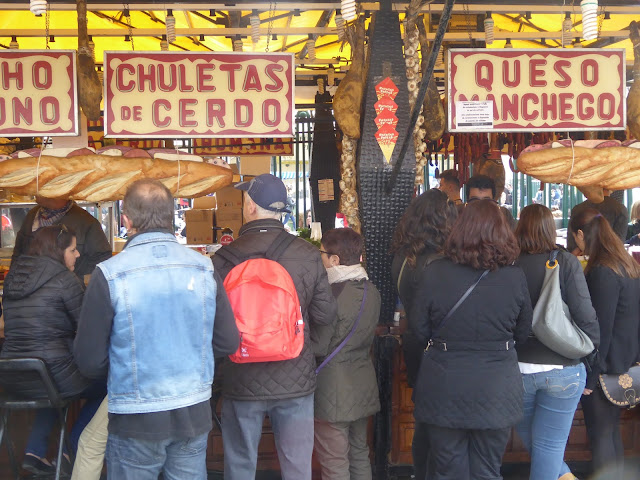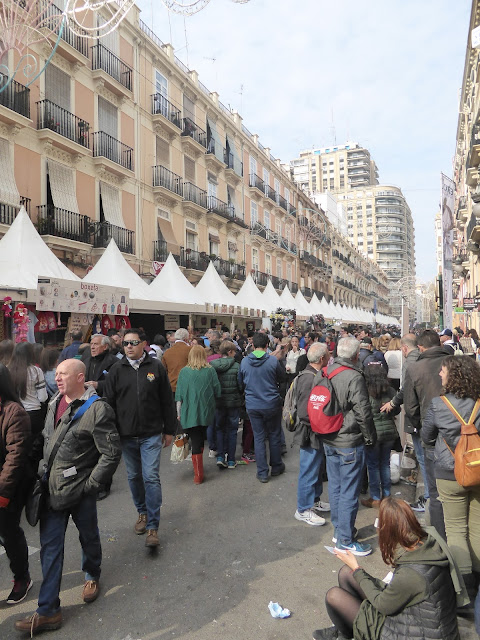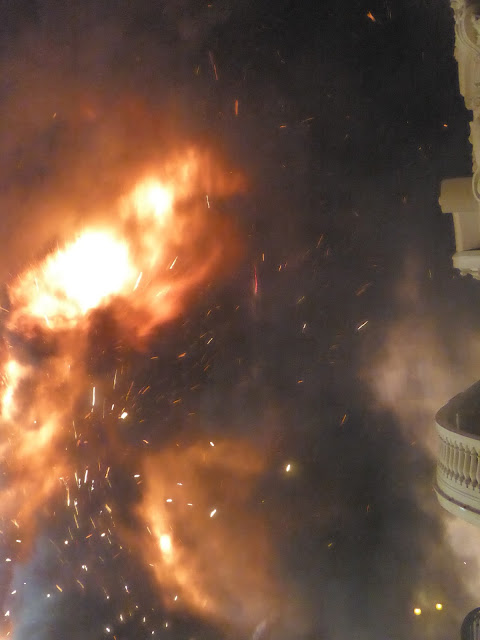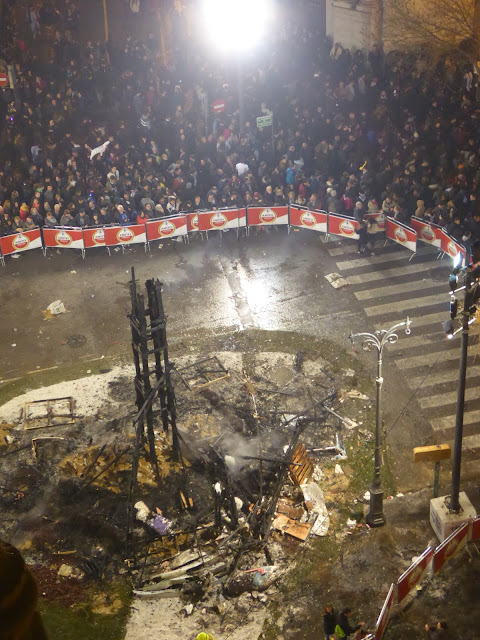(Edited from Wikipedia with personal observations added)
Background
Background
Falles (Valencian)/Fallas (Spanish) - pronounced, "FI-es"/"FI-as" - is a traditional celebration held in commemoration of Saint Joseph in Valencia. The term Falles refers to both the celebration and the monuments created during the celebration. A number of towns in the Valencian Community have similar celebrations inspired by the original Fallas de Valencia celebration. Each neighborhood of the city has an organized group of people, the Casal faller, that works all year long holding fundraising parties and dinners, usually featuring the famous dish, paella, a specialty of the region. Each casal faller produces a construction known as a falles which is eventually burnt. A casal faller is also known as a comissió fallera.
History
This tradition continued to evolve. The parot was dressed with clothing so that it looked like a person; features identifiable with some well-known person from the neighborhood were often added as well. To collect these materials, children went from house to house asking for una estoreta velleta (an old rug) to add to the parot. This became a popular song that the children sang as they gathered all sorts of old flammable furniture and utensils to burn in the bonfire with the parot. These parots were the first ninots. With time, people of the neighborhoods organized the building of the falles and the typically intricate constructions, including their various figures, were born.
During Falles, many people wear their casal faller dress in regional and historical costumes from different eras of Valencia's history; the dolçaina and tabalet (a kind of Valencian drum) are frequently heard, as most of the different casals fallers have their own traditional bands.
Events
The timing of the events is fixed and they fall on the same dates every year, March 15-19.
La Despertà
Each day of Falles begins at 8:00 am with La Despertà ("the wake-up call"). Brass bands appear from the casals and begin to march down every street playing lively music. Close behind them are the fallers, throwing large firecrackers in the street as they go.
La Mascletà
The Mascletà, an explosive barrage of coordinated firecracker and fireworks displays, takes place in each neighbourhood at 2:00 pm every day of the festival; the main event is the municipal Mascletà in the Plaça de l'Ajuntament where the pyrotechnicians compete for the honor of providing the final Mascletà of the fiestas (on 19 March). At 2:00 pm the clock chimes and the Fallera Mayor (dressed in her fallera finery) will call from the balcony of City Hall, Senyor pirotècnic, pot començar la mascletà! ("Mr. Pyrotechnic, you may commence the Mascletà!"), and the Mascletà begins.
La Plantà
The day of the 15th all of the falles infantils are to be finished being constructed and later that night all of the falles majors (major Falles) are to be completed. If not, they face disqualification.
L'Ofrena de flors
In this event, the flower offering, each falla casal takes an offering of flowers to the Virgin Mary as Our Lady of the Abandoned. This occurs all day during 17–18 March (starting in the early afternoon and continuing almost to midnight). A statue of the Virgin Mary and its large pedestal are then covered with all the flowers.
Els Castells and La Nit del Foc
On the nights of the 15, 16, 17, and 18th there are firework displays in the old riverbed in Valencia. Each night is progressively grander and the last is called La Nit del Foc (the Night of Fire).
Cabalgata del Fuego
On the final evening of Falles, at 7pm on March 19, a parade known in Spanish as the Cabalgata del Fuego (the Fire Parade) takes place along Colon street (leading to) Porta de la Mar square. This spectacular celebration of fire, the symbol of the fiesta’s spirit, is the grand finale of Falles and a colourful, noisy event featuring exhibitions of the varied rites and displays from around the world which use fire; it incorporates floats, giant mechanisms, people in costumes, rockets, gunpowder, street performances and music. (Canceled this year due to high winds.)
La Cremà
On the final night of Falles, around midnight on March 19, all of the falles are burnt as huge bonfires. This is known as La Cremà (the Burning), the climax of the whole event, and the reason why the constructions are called falles ("torches"). Traditionally, the falle in the Plaça de l'Ajuntament (the town center) is burned last around 1:30 A.M. Many neighbourhoods have a falla infantil, a children's falla, smaller and without satirical themes, which is held a few metres away from the main one. This is burnt first, at 10:00 P.M.
(The rest are ostensibly burned around midnight. The fire department sends teams to each falle to supervise the burning and it is clear that they cannot be everywhere at once. In my barrio, the falle was not ignited until around 2:30 A.M. A large contingent of the neighborhood residents, including their young children, waited patiently for the denouement.)
Each falle is laden with fireworks which are lit first. The construction itself is lit either after or during the explosion of these fireworks. Falles burn quite quickly, and the heat given off is felt by all around. The heat from the larger ones often drives the crowd back a couple of metres, even though they are already behind barriers that the fire brigade has set several metres from the construction. In narrower streets, the heat scorches the surrounding buildings, and the firemen douse the façades, window blinds, street signs, etc. with their hoses to stop them catching fire or melting, from the beginning of the cremà until it cools down.
Away from the falles, people frolic in the streets, the whole city resembling an open-air dance party, except that instead of music there is the incessant (and occasionally deafening) sound of people throwing fireworks around randomly. There are stalls selling products such as the typical fried snacks porres, xurros and bunyols, as well as roasted chestnuts or trinkets.
On the “Day of Crida,” the last Sunday in February, Valencia’s mayor, Rita Barberá, announces to an enormous waiting crowd, “ya estem en Falles.” Translation from the Valencian: “We are now in Falles.” With this, the city is transformed. Join in the festivities. Remember though, the falles you see here have already disappeared, gone up in smoke. The centuries-old tradition continues.
THE FALLES, AT RANDOM.

FOR THE CHILDREN
EACH LARGE-SCALE FALLES IS ACCOMPANIED BY A SMALL-SCALE FALLES PARTICULARLY FOCUSED AT CHILDREN. HERE ARE TWO THAT RIVALED THEIR MUCH LARGER PARENTS

MEANWHILE, ON THE STREET...
LOTS OF BALLOONS.

...AND THE SOMETIMES COMPLICATED MECHANICS OF GETTING
THEM IN THE HANDS OF THE CHILDREN.
THEM IN THE HANDS OF THE CHILDREN.
THE FOOD
THE PEOPLE OF FALLES

THE SECOND PLACE WINNERS, CASAL PILAR,
THE MOST "IN YOUR FACE" OF THE FALLES I SAW.
STREET SCENES
NOT TO BE FORGOTTEN, FALLES CELEBRATES THE
FEAST DAY OF SAINT JOSEPH, PATRON SAINT OF CARPENTERS.
FEAST DAY OF SAINT JOSEPH, PATRON SAINT OF CARPENTERS.
"If there is one event that stands out above all others, it is the floral offering to the Virgen de los Desamparados (Our Lady of the Forsaken); all the falla groups meet at their casal (headquarters), dressed in traditional costume. From all parts of the city the groups converge on the Plaza de la Virgen, accompanied by musical groups and carrying bunches of flowers to be placed at the feet of the figure of the Virgin."
(The flowers are then transferred to the wooden framework of the Virgin by swarms of volunteers in a process that takes two full days.)
(The flowers are then transferred to the wooden framework of the Virgin by swarms of volunteers in a process that takes two full days.)
PERHAPS, ONE OF THE FORSAKEN (FREDERICK FORSYTH NOVEL
NOT WITHSTANDING...)
UP CLOSE AND PERSONAL:
MARCH 1 -19
TUCKED BENEATH MY NEW HOME, THE FESTIVAL HAS BEGUN WITH CROWDS SWARMING TO GET WITHIN A COUPLE OF BLOCKS OF THE AYUNTAMIENTO, CITY HALL PLAZA, WHERE STARTING ON MARCH 1, A BARRAGE OF ARTILLERY-LIKE FIREWORKS ARE SET OFF FOR FIVE MINUTES PRECISELY AT 14:00 HOURS. THE ORCHESTRATED, ALMOST MUSICAL, BLASTS ARE LOUD ENOUGH TO RATTLE MY WINDOWS.
AFTERWARDS, TO HELP CLEAR THE STREETS, PERCUSSION BANDS PLAY RAPID MARCH MUSIC TO HELP DISPERSE THE CROWDS.

AROUND MARCH 10, THE PIECES OF THE LOCAL FALLES, THE NINOT, BEGIN
TO ARRIVE AT THE SITE.

WITHIN TWO DAYS, THEY ARE UNWRAPPED AND BEGUN TO BE ASSEMBLED.

ON MARCH 12, A FEW DAYS BEFORE THE BUILDING OF THE FALLES THROUGHOUT THE CITY ON MARCH 15, MINE IS READY AND SPOTLIT. IT IS COMPLETED EARLY TO WELCOME THE HUNDREDS OF THOUSANDS OF PEOPLE ARRIVING IN THE CITY FROM THE NEARBY MAIN TRAIN STATION.

THE FINAL NIGHT OF FESTIVAL BRINGS LA CREMA,
, THE BURNING OF THE FALLES. MORE CROWDS BEGIN TO GATHER TO WATCH THE CONFLAGRATION.
AFTER NEARLY TWO HOURS OF PREPARATION,THE MASS OF PEOPLE ALSO FILLS THE ENTIRE THREE BLOCKS PERPENDICULAR TO THE MAIN AVENIDA. THE CROWDS HAVE BEEN PUSHED BACK AS FAR AS THEY WILL GO.
CONTROLLED FIREWORKS ARE SET OFF FROM WITHIN THE SCULPTURE, LIGHTING THE SKY AND IGNITING THE SCULPTURE. IT IS ALMOST MIDNIGHT, THE TIME WHEN ALL OF THE FALLES - EXCEPT THE CITY'S SCULPTURE ON THE AYUNAMIENTO ARE SUPPOSEDLY TO BE DESTROYED - LEAVING ONLY THE AYUNAMIENTO STATUTE TO BE SET ABLAZE.
STANDING ON THE TERRACE OF MY HOME ON THE 7TH LEVEL OF
THE BUILDING, HERE ARE TWO EYE-LEVEL VIEWS.
AND THE CLOUD OF BLACK SMOKE BILLOWING FROM BELOW.
ONE NINOT, THE INDIVIDUAL FIGURES THAT COMPOSE THE FALLES,
STRUGGLES TO AVOID THE FLAMES.
....AND IS QUICKLY CONSUMED.
A PLATOON OF FIREMEN HOSE DOWN THE FALLES DURING THE ENTIRE BURN. SO MUCH WATER IS THROWN AT THE FIRE THAT, STANDING ON MY BALCONY, DESPITE THE BLAST OF HEAT, I ACTUALLY FELT MOISTURE.
TEN MINUTES LATER.
FORTY-FIVE MINUTES LATER.
IT IS A PROCESS TO BE REPEATED THROUGHOUT THE CITY AT UPWARDS OF THREE HUNDRED SITES (ALBEIT NOT THAT MANY AS LARGE AS THIS ONE)
FOR SEVERAL MORE HOURS - DESPITE THE BEST INTENTIONS REGARDING THE MIDNIGHT DEADLINE.
______________________________________
_________________________________________
COPYRIGHT © 2016-2023 BENJAMIN CLAVAN











































